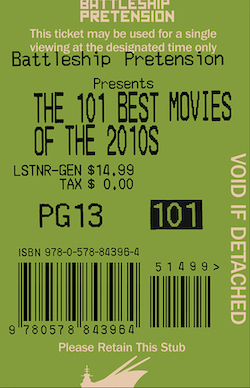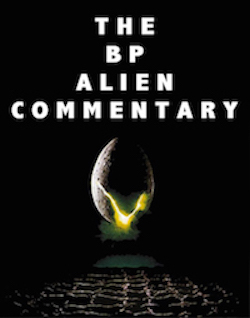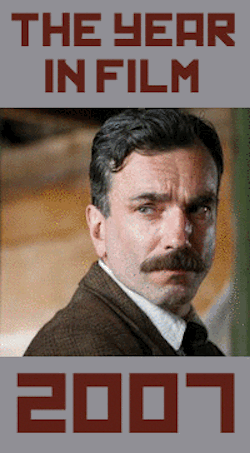A Series of Crimes: M, by Aaron Pinkston
Fritz Lang’s crime thriller M is both a technical masterpiece and a genre trendsetter. Released in 1931, it is perhaps the first film of the sound era that uses the cinema’s new toy to great effect. Lang shapes the film’s editing so in tune with his ability to provide spoken dialogue and sound effects that it is a film that simply couldn’t have existed only a few years before. The filmmaker even understands the effect well enough to sprinkle in tricks and aural jokes throughout the film, going so far as to damn the film’s villain with the sounds that he makes. There is much more that could be said about the use of sound and the film’s other technical traits, but there is also a lot to be said in the context of the crime film, the study of this series.
Taking place in urban Germany after the first World War, this society was prime to give us the first great cinematic serial killer. There were plenty of killers, crooks and monsters throughout the silent cinema, but perhaps nothing that comes near the humanity and complexity of Hans Beckert. German society at this time was in complete chaos, in a great moral and economic depression coming after its devastating loss; M perfectly explores the seeds that would sprout into the rise of Nazism — Lang and screenwriter Thea von Harbou (Lang’s wife at the time) both had complicated and differing relationships with the Nazi party, but both definitely foretold how the phenomenon could arise without ever actually addressing it. In the film, as young children go missing, this already fragile society erupts into mistrust of each other and governmental systems. People are scrutinized for their actions and friends are willing to sell out friends with the slightest proof — perhaps to solve the crime, perhaps to save themselves from accusation.
With this backdrop, M fully explores a type of criminal that has long been among the most vilified: the sexual predator of children. To great surprise, though, M has the audacity to turn the whole thing around and ask the audience to consider if this most vile of human deserves sympathy. Through most of the film, we don’t know much about Hans Beckert. We see him in the stages before his crimes, luring children with treats, and otherwise sulking around. Before the film’s incredible climax, he doesn’t have much of a voice — something of a funny joke given the character’s ability to literally speak. Really, though, M is setting the audience up to hate this man. It shows him as sick and tortured, but more a lunatic who stares into a mirror making crazy faces at himself (with voiceover telling us that this type of man would be the type who stares into a mirror making crazy faces at himself). We don’t quite get to see him as a full human being until the last moments, after he is caught and has to reveal himself. Played extraordinarily well by character actor extraordinaire, Peter Lorre, Beckert is menacing, pathetic, over-the-top and, eventually, a real life human being.
The real genius of M is seen in the final scenes, when we are forced to sit face-to-face with human evil and see the humanity, hear it in his pleas. As Beckert is pleading for his life, babbling that he simply can’t control himself, even if you flatly disregard this sexual predator as pure evil, you can’t help but scrutinize your own impulses, both the simple and the vile. There is a theory in horror films that it is better to not see the monster because the imagination of what that monster may be is actually more frightening. M shows that in the crime film, you have to see the monster to realize he is real. Everything in the character turns on a dime, but not in a jarring way. Credit again must go to Lorre, who plays his triumphant speeches both as an animal trapped in a corner and with a sadness that is just below the surface.
Within the trial scene, even though it is basically a kangaroo court made up entirely of criminals, we see a modern and intelligent debate over society’s role in handling its monsters. Should sick individuals be given over to the doctor or the executioner? This is a particular discussion that is difficult to have in a civil manner, but the film can properly appeal to both sides, rational and emotional. Lang doesn’t solve the debate (the film ends without hearing a sentencing) or really give us a personal statement, but he avoids having it both ways or simply waving his finger at the audience. Instead, he highlights the complicated nature of this debate and allows viewers to make the ultimate decision for themselves.
As much as M is about the criminal at the film’s center, it also says a whole lot about the criminal process — setting it apart from many similar crime stories. It both shows why the criminal justice system is vital while also a complete takedown of the institutions of the time. Police are depicted as incompetent and powerless. Their investigation is tedious to the extreme, with officers trying to break the case with evidence as meaningless as a candy wrapper. Eyewitnesses knowingly or unknowingly make up information and are motivated not by doing the right thing but to become the hero. With these impediments, it is incredible that they could ever get anything done. On the other hand, it depicts a world with crime so heinous that police consider the right to form a police state where the rights of everyday citizens are taken away. In order to prove you are not a criminal, you must be treated like a criminal. It’s a backwards sort of idea, but one that can live in a world where monsters can exist. As long as there are Hans Beckerts freely walking the streets, there are no limits in trying to stop them.
Opposing the police force in M are perhaps the film’s true heroes: organized crime. This series will look at a number of gangsters, but M is unique. The mob here doesn’t necessarily start their own investigation because they are completely repulsed by the actions of the child killer (though they are quick to say as much when looking for a reason to kill him), but primarily because the heightened police state basically makes it harder for them to live as criminals. On a number of occasions throughout the film their lifestyles are superimposed with the crimes of Beckert — in their minds they have the right to make a living which affords them the right to be criminals. Beckert, on the other hand, doesn’t commit his crimes to feed himself or his family, but either out of a sick pleasure or a sick compulsion. Perhaps any regular civilian who have the same impulse, but it doesn’t quite make rational sense — can we defend a section of criminals just because they aren’t that bad? This feeds into one of the great ideas of the crime film, in that normal people can get sucked into this world. It’s essentially OK, at least it is understandable to become a criminal if the intentions are right. But if the criminal intentions can’t be understood in the constraints of a healthy society, we have a problem.
M constantly inverts societal norms. The “evil” villain gets the most sympathy and emotion, as really the only character to look into the camera and explain himself. The victims, whether the slain girls or their families, are mostly afterthoughts, voiceless for much of the film. Cops are ineffective dummies while the mob and the homeless are true heroes. M’s conclusion perfectly works with these contradictions. Criminals are contemptible and misunderstood. By film’s end, we both hate Beckert and suffer with him. And that’s why we love crime films so much.





























